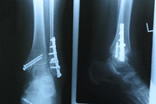
 Wide Receiver Sammy Watkins had foot surgery in April to repair a stress fracture in his left foot, and had gradually increased his activity so that he could make a return for the season opener. Watkins had started in the season opener, but had to be evaluated the next day for what appeared to be soreness in his foot. Watkins, however, was confident that the pain was not a cause for alarm. However, according to the article, it is crucial for an athlete to properly recover and take it slow after healing from a stress fracture injury, as the bone is still remodeling itself and the risk of injury is still high.
Wide Receiver Sammy Watkins had foot surgery in April to repair a stress fracture in his left foot, and had gradually increased his activity so that he could make a return for the season opener. Watkins had started in the season opener, but had to be evaluated the next day for what appeared to be soreness in his foot. Watkins, however, was confident that the pain was not a cause for alarm. However, according to the article, it is crucial for an athlete to properly recover and take it slow after healing from a stress fracture injury, as the bone is still remodeling itself and the risk of injury is still high.
Activities where too much pressure is put on the feet can cause stress fractures. To learn more, contact Dr. Sybil J. Fisher of Texas. Our doctor can provide the care you need to keep your pain free and on your feet.
Dealing with Stress Fractures of the Foot and Ankle
The Stress Fractures occur on the foot and ankle when muscles in these areas weaken from too much or too little use. Then the feet and ankles lose support when walking or running from the impact of the ground. Since there is no protection the bones receive the full impact of each step. The stress on the feet causes cracks to form in the bones, thus called stress fractures.
What are Stress Fractures?
Stress fractures occur frequently in individuals whose daily activities cause great impact on the feet and ankles. Stress factors are most common among:
-runners
-people affected with Osteoporosis
-play tennis or basketball
-gymnastics
-high impact workouts
Symptoms
Pain from the fractures occur in the area of the fractures, and can be constant or intermittent. It will often cause sharp or dull pain with swelling and tenderness. Engaging in any kind of activity which involves in high impact will aggravate pain.
If you have any questions, please feel free to contact one of our offices located in Houston and Sugar Land, TX. We offer the newest diagnostic and treatment technologies for all your foot care needs.
Copyright © 2016 S.J. Fisher DPM | Site Map | Design by: Podiatry Content Connection